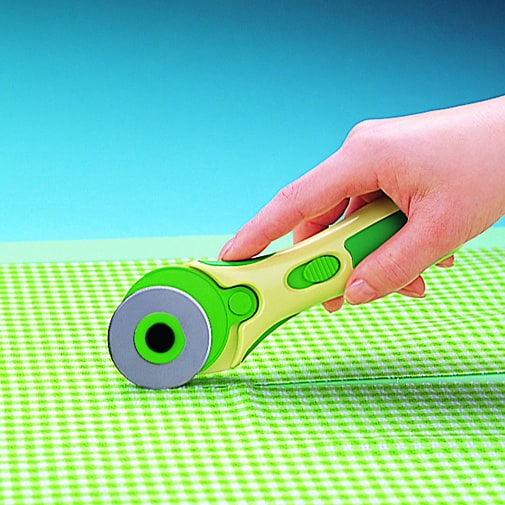What is it? – Every now and then a sewing tool comes along that truly changes the way we sew. Point in fact, the rotary cutter, a true renaissance tool. Scissors are great, and still have their place, but they make our hands hurt, are hard to keep sharp (especially around husbands and children), require us to manipulate the fabric while cutting it, don’t like cutting layers or following lines and generally distort our fabric when cutting. Only five thousand years after the invention of the wheel some genius applied the same principle to cutting fabric and we now enjoy the luxury of the rotary cutter. They are easy to hold, are extremely sharp, effortlessly cut multiple layers of fabric, are adept at following lines and templates and cut so cleanly on flat laying fabric that little or no distortion or fraying results. How cool. I told you that Clover doesn’t do gadgets and we don’t. We also don’t change what works just for the sake of change. What we have done with the Clover Rotary Cutter is take the concept to a whole new level of performance with due consideration to both the user and an entire range of sewing applications.
What does it do? – Very simply put it makes the most demanding cutting applications easy and precise.
- Ergonomic is too clinical to describe Clover’s blend of form and function to make a tool that is easy to hold and efficient to use. The handle is soft and fits comfortably in your hand. The blade and movable shield work together to result in a precise angle so it’s easy to cut either sitting or standing. It takes only seconds to set it up for either left or right handed operation.
- In quality and performance, Clover rotary blades are unsurpassed. Made from high grade carbon steel and honed to an optimum blade angle, Clover blades are both sharp and durable.
- Size matters. A gourmet chef uses several sizes of knives to prepare a meal. She could probably get by with just one but why would she? The same principle applies to cutting fabric. When cutting several layers of fabric or long strips a large 60 millimeter rotary blade makes sense. When cutting small patterns or using tight radius templates it is so much easier to manipulate an 18 millimeter rotary blade. For projects in between there are 45 and 28 millimeter rotary blades. Fit the tool to the task for best results. Simple.
- All rotary blades are made from super hard steel and are sharpened at very precise angles using heavy duty, computer controlled industrial equipment. Your chances of matching the factory angles and grinding performance with a plastic “sharpener” at home are almost zero. Replace warn used blades with sharp new blades. You’re worth it. So is your fabric.
Watch the latest Tool School
[youtube=http://www.youtube.com/watch?v=kicOiYDXw4E]
